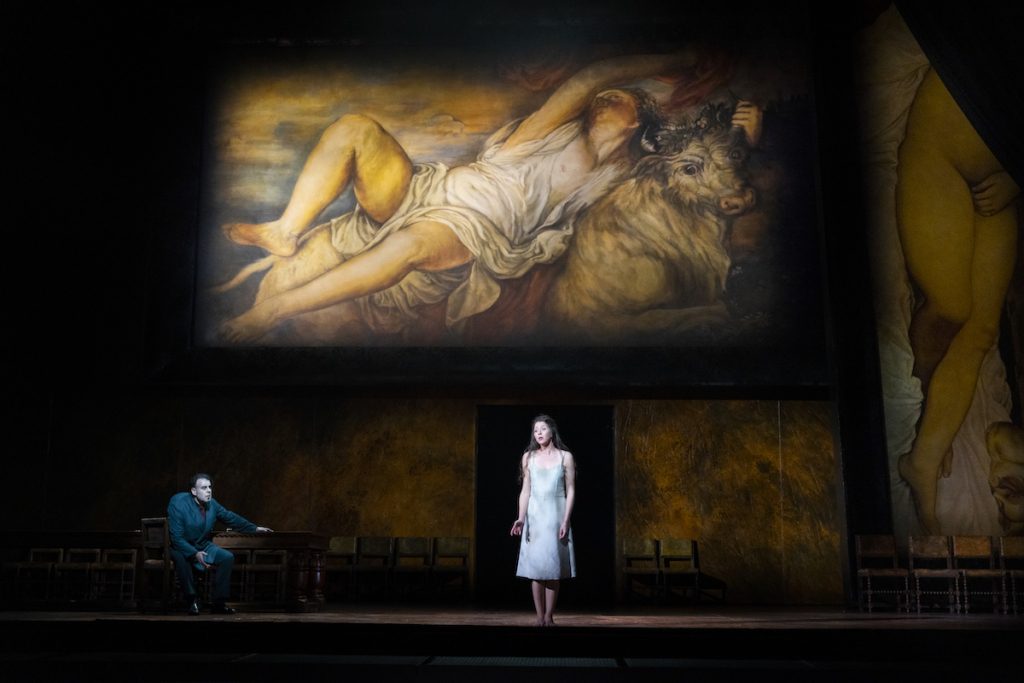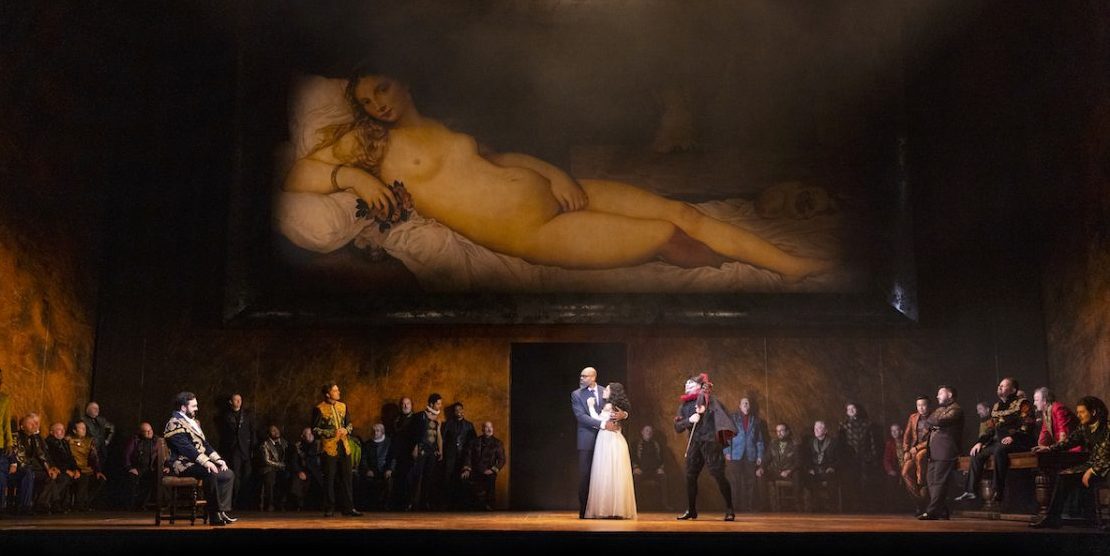An air of some excitement and anticipation hangs in the packed Royal Opera House’s auditorium. This is the first performance since the first COVID-19 lockdown in March 2020. The season has opened with a new production directed by Oliver Mears. This is his first new staging in the house and his first collaboration with the conductor, Maestro Antonio Pappano. Mears’ direction is interesting and thought provoking, yet his Rigoletto borders on the conventional.
This Rigoletto is not situated within any fixed frame of time or location. The duke’s palace in Mantua is a vast hall with high smooth walls coloured faux copper with patina (set designer Simon Lima Holdsworth). There is no hint of opulence in the décor nor the costume (designed by Ilona Karas). Dramatic features are introduced to inspire suspense – for example, the curtains are raised during the prelude, revealing a ‘freeze-frame’of intertwined figures, including one wearing a bucranium (an ox skull), another a young female dressed in white, lying on the ‘plinth’ that simulate an altar. Once the figures disassemble, the bucranium-headed figure steps onto centre stage, with a female on either side and an Italian 16th century stiletto dagger held on his right hand. The ox skull (symbol of death) is removed to reveal the Duke of Mantua (Liparit Avetisyan), echoing the curse motive “Quel vecchio maledivami” in the prelude.
Some recent productions of this masterpiece are placed within a modern historical theme like the #MeToo movement or the Jeffrey Epstein episode. Mears steps back and does what may not be considered, by some, as popular. Here, women are not victims but willing participants and to some extent complicit in their fate.
Two Titians paintings loom large as silent witnesses. In Act I, the Venus of Urbino. a painting known for its explicit sensuality within a domestic setting. In this Act Gilda, Rigoletto’s only daughter is smothered by her father’s devotion and love but feels liberated by the Duke’s sweet words of love. There is a touch of her sexual awakening and desire to be carried away by true love.
In Act II Titian’s The Rape of Europa dominates the hall. This image is a close-up on the abduction and rape of Europa. In the original Titian painting, Europa waives a red scarf as a plea for help or signal of her plight. Yet, the red scarf has been omitted here, as if to say, Gilda was horrified, as she tells her father, but did not shout for help. Gilda is abducted by the Duke’s cronies and out of sight, she is raped or seduced by the man she actually loves.

Gilda’s rape is behind closed doors, while the masked cronies peep through the keyhole, Maddalena, the assassin Sparafucile‘s sister, initiates sex with the Duke. He is the passive partner, with she on top, riding high almost triumphantly, accentuating female control.
Lisette Oropesa’s Gilda is enthralling musically and utterly engaging dramatically. Oropesa skilfully delivers the arc of Gilda’s gradual character evolution, blossoming into her lyric and dramatic role, as she becomes of age.
Ramona Zaharia’s Maddalena is powerful and flirtatious. Liparit Avetisyan’s the Duke is more of a romantic seducer and his warm velvety voice add to his projected character as a harmless seducer. Carlos Alvarez as Rigoletto conveys beautifully the pain he carries as a jester with physical deformity and his utter discomfort with the world he lives in. His acid tongue mocks but also utters tender affection to Gilda. He embodies conflicting worlds. On the opening night his voice lacked emotion. He stopped short of delivering the depth of the complex and unsettling emotions associated with his character.
Last but not least the orchestra, conducted by Pappano, perfectly conveyed the drama embedded in the opera. All male performers sounded restrained in the first Act. It was only after the interval that emotions surfaced, and the male characters delivered a performance that earned them applause from enthusiastic audience. As one member of the audience said to me: ‘it was good but not brilliant but still an excellent night out’.

